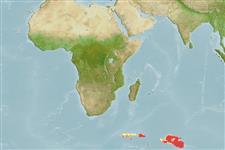Environment: milieu / climate zone / depth range / distribution range
Ecology
Marine; benthopelagic; depth range 30 - 1600 m. Polar; 44°S - 56°S, 39°E - 76°E (Ref. 1371)
Southern Ocean: known only from the Crozet, Kerguelen and Heards islands.
Size / Weight / Age
Maturity: Lm ? range ? - ? cm
Max length : 44.0 cm TL male/unsexed; (Ref. 124276); common length : 30.0 cm TL male/unsexed; (Ref. 1371); max. published weight: 780.00 g (Ref. 124276)
Dwells on continental and insular shelves and slopes. Feeds on zooplankton.
Life cycle and mating behavior
Maturity | Reproduction | Spawning | Eggs | Fecundity | Larvae
Cohen, D.M., T. Inada, T. Iwamoto and N. Scialabba, 1990. FAO species catalogue. Vol. 10. Gadiform fishes of the world (Order Gadiformes). An annotated and illustrated catalogue of cods, hakes, grenadiers and other gadiform fishes known to date. FAO Fish. Synop. 125(10). Rome: FAO. 442 p. (Ref. 1371)
IUCN Red List Status (Ref. 130435: Version 2024-2)
Threat to humans
Harmless
Human uses
Fisheries: of no interest
Tools
Special reports
Download XML
Internet sources
Estimates based on models
Preferred temperature (Ref.
123201): 1.3 - 2.9, mean 2.1 °C (based on 75 cells).
Phylogenetic diversity index (Ref.
82804): PD
50 = 0.5059 [Uniqueness, from 0.5 = low to 2.0 = high].
Bayesian length-weight: a=0.00437 (0.00171 - 0.01116), b=3.11 (2.89 - 3.33), in cm total length, based on LWR estimates for this (Sub)family-body shape (Ref.
93245).
Trophic level (Ref.
69278): 3.4 ±0.45 se; based on food items.
Resilience (Ref.
120179): Medium, minimum population doubling time 1.4 - 4.4 years (Preliminary K or Fecundity.).
Fishing Vulnerability (Ref.
59153): Low to moderate vulnerability (34 of 100).
Climate Vulnerability (Ref.
125649): Moderate vulnerability (40 of 100).
Nutrients (Ref.
124155): Calcium = 20.2 [11.0, 50.0] mg/100g; Iron = 0.381 [0.174, 0.799] mg/100g; Protein = 15.7 [14.4, 17.1] %; Omega3 = 0.229 [0.100, 0.507] g/100g; Selenium = 25 [9, 62] μg/100g; VitaminA = 24.9 [4.9, 123.0] μg/100g; Zinc = 0.473 [0.297, 0.760] mg/100g (wet weight);
